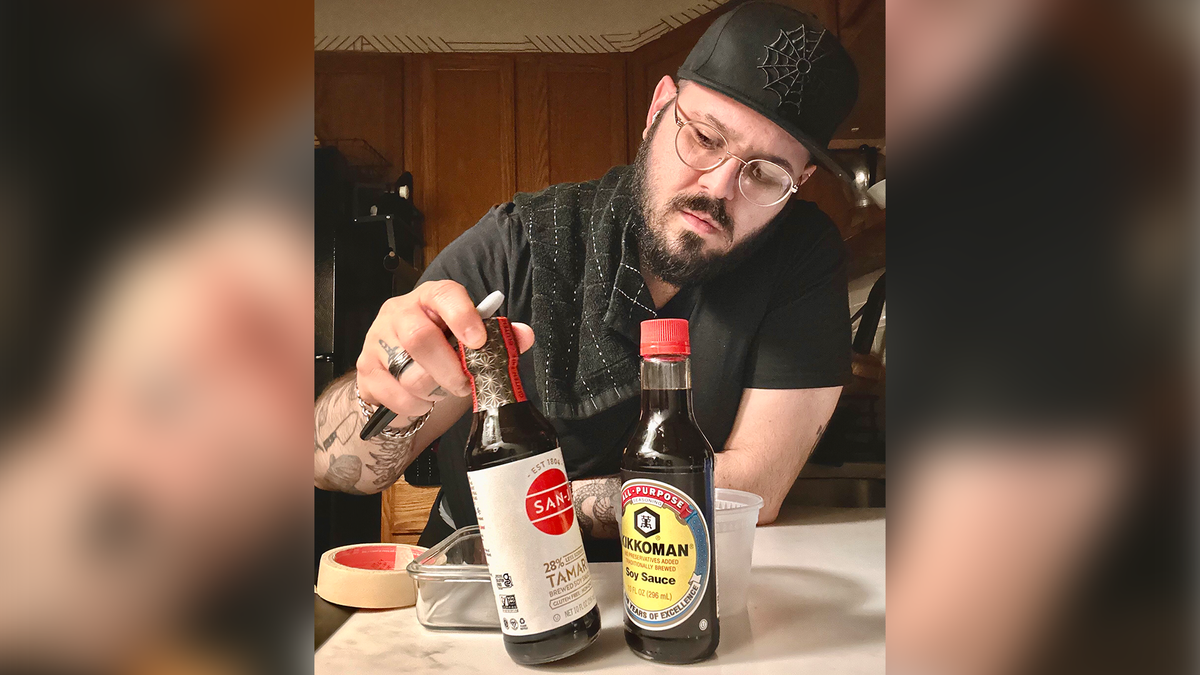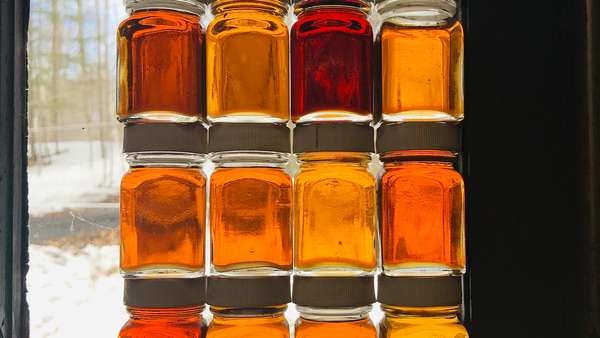Soy Sauce vs Tamari: What's the Difference?
“Well, they both look the same. I’m sure they taste the same”. Is that statement correct? Yes and no.

You’re standing there in the aisle. You’re holding your basket that contains some peanut butter, maybe rice, a few rolls of toilet paper, a bag of chips, and some bananas that you will watch turn almost black after days of convincing yourself you will make banana bread. But you won’t. No one does. Just throw them out before you accept the grim fate. You find yourself in what is usually labeled as the “International” aisle in major grocery chains, staring at two bottles next to each other on the shelf. One is soy sauce, the other is tamari. You’re standing there, saying “Well, they both look the same. I’m sure they taste the same”. Is that statement correct? Yes and no.
Let me start off by saying I am a huge believer in using whatever you have on-hand in your home to season or flavor your food. Not everyone has the luxury of stockpiling every sauce and seasoning known in existence in a neat vibey pantry or drawer with everything in uniformed glass bottles and jars with the same labels. As much as it is aesthetically pleasing to see that tedious and potentially psychopathic organization, it’s not realistic for everyone.
Before we dive into any recipes or any common uses, let’s go over the difference between soy and tamari as far as the products themselves. Soy sauce is a fermented sauce that is fermented with soybeans and wheat. So, for anyone who is gluten-free, make sure to read the labels on soy products carefully. Soy sauce became popularized in Chinese cuisine and is still used in both the cooking and finishing process with a lot of Chinese dishes. Soy is of course used in a multitude of ways in various dishes and is not specific to Chinese cuisine. But it originated there, and when you pair it perfectly with actual Chinese dishes, it makes sense. Like the classic amazing Hunan dish Hong Shao Rou, aka Red Braised pork belly, dipping those in soy just helps perpetuate the already amazing and sticky flavor on the sauce. Red braised pork is what we in the U.S., and especially NY and NJ know as “Boneless Spare Ribs”. The weird, inbred bastardized version of Hong Shao Rou. Please don’t let that snobby remark lead you to believing that I look down on quickly made Chinese boneless spare ribs. I was born in NYC and grew up 20 minutes from Manhattan. Quick amazing takeout style Chinese food was a comfort that still to this day warms my fat little heart, both medically and emotionally. Shoutout to East Bamboo in Eastchester for all the tasty meals.
While soy sauce comes from fermenting soybeans and wheat amongst other things; with the intention of making an actual sauce, tamari is uniquely different. Tamari, known more in Japanese cuisine, is actually the byproduct you get in the miso making process. Although it is said that there’s a possibility the product originated in China, it certainly has become more prominent in Japanese cuisine. Tamari also contains no wheat, so most of the time the bottles are gluten-free friendly. Tamari may be the runoff liquid from the miso paste production process, but the umami flavor produced is undeniable. It’s thicker and there are more soybeans used in the process. So you end up with this thick, soy forward rich sauce that can be used in cooking or as a finishing sauce.
Both these products originate from soybeans, which means they do have similar flavor profiles, so the real question is…are they interchangeable? Well, let’s find out.
The best way to tell the real difference in both products is to do what all discerning chefs SHOULD do, TASTE it. I took a spoon and ingested a sodium full slug of both varieties. And I have to say, now that the background has been made clear, it makes so much more sense. The soy is watery, and definitely more salt forward. The tamari was smooth, thick, had a richer flavor, and SO much more soy forward. Which makes sense considering that there are way more soybeans used in the tamari brewing process.

I decided to try this out on something I use a lot, which is cured egg yolks. If you’ve never cured egg yolks in soy sauce, then please do it. Yes, it’s as easy as it sounds. You place the separated egg yolk in the liquid, and once it’s floating all happy, drape a little scrap of paper towel over it. What this will do is soak up the soy or tamari and it will drape over the yolk, insuring you cover that sensory nightmare of a yolk texture with that beautiful soybean juice. My initial thought (fear) was that since the soy sauce had more than 250mg more sodium per tablespoon, that the tamari would not effectively draw out the moisture as I wanted, and it would effectively not be the jammy jammy spreadable seed of my loins that I was imagining. While those take a few days to cure, let’s move on to a quicker experiment and we’ll revisit those bad boy pre-birds in 40 hours or so.
Let’s make one of my favorite go-to dressings. This could be a salad dressing, drizzled onto a sandwich, mixed into cold (or hot) noodles, thrown into the pan whilst frying rice, and then topped after. The possibilities are literally endless for this dish. The recipe is simple and truthfully, I eyeball this in a mason jar, close the lid, and shake it like those inspirationally brave souls who lead the advertising visuals for the Shake Weight. But it’s basically this: start with a half cup each of oil and vinegar (preferably rice vinegar) mix in two tablespoons each of honey (or maple syrup if you want to get weird) your soy/tamari and sesame oil. If you have tahini…use the damn tahini! Then crack in some black pepper to taste and a three-finger pinch of chili flakes if you’d like. The texture is WAY better.
For those who realize that I’m a dummy for writing it out like that, here it is:
- 1⁄2 cup oil
- 1⁄2 cup rice vinegar
- 2 tbsp. honey or maple syrup
- 2 tbsp. soy or tamari
- 2 tbsp. sesame oil or tahini
- 2 tsp. black pepper (to taste)
- 1 tsp. red chili flakes (optional)
Now, I made this with sesame oil, not tahini, and I made it with both tamari and the soy sauce. I have to say, tamari won this one. The silkier, thicker body emulsified into the dressing so much better than the soy. The soy is a lot more watery, and TO MY SHOCK, water and oil don’t mix well. WHO KNEW?!
But seriously, the tamari adds a smoother less salty taste, and it’s so subtle that everything I have ever loved about this dressing just got better and didn’t get ruined. My fear was that I would try this with tamari for the first time and THROW the bottle against the wall, waking my child, scaring my wife. The cat runs and hides under the bed as my voice bellows through our apartment cascading through the walls as our neighbor just hears, “HOW DARE YOU BESMIRCH THE GOOD NAME OF THE SAUCE YOU MISO PASTE REJECT!” But alas… I was pleasantly surprised with the outcome.
Through the magic of professional editing, it’s now 48 hours later and it’s time to try our egg yolks which I have laid them out in hot bowls of noodles. I just wanted to REALLY taste them. But, since you are still here, and if you’ve made it this far then you’ve been through a lot already. Let me give you some practical uses for these ingredients…hot ramen; add this into a piping hot bowl of ramen for an incredible umami blast into your mouth. And then really let that line you just read sit with you in a horribly uncomfortable way every time you consume an egg yolk.
Next, and this one’s a doozy… atop toast. Toast up some nice bread of your choosing and spread these jammy yolks on there, maybe top them with some diced scallions or even some pickled veggies to get real weird. And my favorite (excluding red sauce) is accompanied with a pasta. I am talking about pasta with veggies, or a cacio e pepe, or even just an aglio e olio dish. When the pan’s residual heat is still there once it’s been shut off, throw that in and mix vigorously until that silky smooth creaminess coats those pasta strands like a warm umami blanket.
You’ve survived the ramblings of a mad man who got hyper focused on soybean products and for that, you deserve an award OR at the bare minimum a cuddle. Regardless, here’s my takeaway: Are these interchangeable? Sure. If you don’t have soy, you can absolutely sub with tamari. Do I recommend using tamari more than soy? Absolutely. No offense to traditional soy sauce or any of its evil cousins like low-sodium soy sauce or dark soy sauce, but tamari just has more to offer. Tamari is thicker, it’s richer, it’s naturally less salty. It has all the flavor profiles of what we know as soy sauce but without the water and salt high sodium content.
My elevator pitch for tamari is this: start by replacing it in any recipe you’d usually use soy sauce in. Then, start reducing the amount of ingredients and let the flavor of the tamari come forward. Start using it in your noodles, your dressings and your cures. Anything you can.
And remember…keep cooking. Keep eating. Keep your knives sharp and RELAX that mind. Stay classy, my darlings


